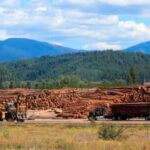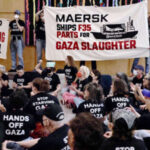Armored National Guard trucks rumbling down Sunset Boulevard. The mayor declaring a citywide curfew. LAPD officers in riot gear firing flash bangs and rubber bullets. Street medics rushing to neutralize tear gas.
I watched all this unfold on the streets of Los Angeles five years ago — in June 2020, when I lived in the city and saw firsthand how peaceful Black Lives Matter protesters were met with violent repression.
In the years since, the city has paid out nearly $12 million in legal settlements and jury awards stemming from well-documented LAPD abuses at that summer’s protests. An independent report commissioned by the Los Angeles City Council, released in 2021, found that the LAPD had acted chaotically and belligerently — illegally detaining protesters, deploying force on innocent people, and escalating confrontations with nonviolent protesters.
Five years later, the LAPD’s multibillion-dollar budget has only grown, even as the department overspends on police liability payouts. This context is crucial for understanding the events that erupted in Los Angeles last week amid a wave of Immigration and Customs Enforcement (ICE) raids. In response to the Trump administration’s violent deportation regime, a coalition of community members, of all ages and backgrounds, have gathered in solidarity with their undocumented neighbors. Most of the demonstrations have been concentrated in just a few blocks downtown, a tiny portion of the sprawling city. “Moms, kids, families, it was truly beautiful to see,” said one friend who attended a protest on June 8. “Even when it got violent from the cops — I got hit with a flashbang that cut my arm — there were volunteer field medics and teens handing out water bottles.”
This reality on the ground is a far cry from the picture painted by President Donald Trump and mainstream media, who have attempted to equate scattered scenes of property destruction with widespread, state-inflicted violence against human beings. I remember this same gulf during the 2020 protests, between lived experience and media spectacle. And time and time again, what a large body of research has shown is that the presence of militarized police and the National Guard at protests is often the real instigator of violence, not its pacifier.
Much of the media coverage of the current anti-ICE protests has been on the political showdown between California Gov. Gavin Newsom and Trump. On Saturday, June 7 — just one day after a small group of protesters had assembled outside a detention center in downtown Los Angeles — the president announced that he would deploy around 2,000 National Guard troops to the city. Newsom, who said he was neither consulted nor notified before the announcement, expressed immediate outrage. “Donald Trump is creating fear and terror by failing to adhere to the U.S. Constitution and overstepping his authority,” Newsom said in a June 9 statement. “This is a manufactured crisis to allow him to take over a state militia, damaging the very foundation of our republic.” That day, California announced it had filed a lawsuit against the Trump administration for infringing on state sovereignty, and Trump announced he would send an additional 2,000 National Guard troops, as well as 700 active-duty Marines.
Newsom has continued to rail against Trump for meddling in state affairs. During an interview with Michael Barbaro on the June 12 episode of The Daily, Newsom said: “I think it’s a red line when you’re using military that are trained for foreign incursions to do domestic law enforcement in American cities. If that’s not a red line, I don’t know what red lines mean.”
This is great press for Newsom, who is eyeing a presidential run in 2028. But just five years ago, he crossed his own supposed red line — and deployed approximately 8,000 National Guard troops in California during the protests for racial justice. Most of those soldiers were sent to Los Angeles.
Newsom’s gripes on The Daily, in fact, seem to stem more from the fact that he’d, personally, been slighted by Trump, than from any indictment of how militarized responses to protests inflict harm. He made a point to praise the 1,600 local officers making arrests in Los Angeles and critique how Trump’s sudden deployment meant that soldiers were sitting around with nothing to do. He noted that he reveres the National Guard, and he’s proud to command their activities at the U.S.-Mexico border.
But he failed to say that it was the repressive actions of local law enforcement that sparked the current upsurge of protest in Los Angeles in the first place. The current situation was born on June 6, when David Huerta, the president of one of the largest unions in the U.S., was knocked down and arrested while observing an ICE raid at a garment warehouse. When a couple hundred protesters assembled that evening at the detention center where Huerta was being held, the LAPD declared an unlawful assembly, dispersed tear gas to break up the crowd and announced a citywide tactical alert.
The next day, several hundred protesters clashed with border patrol agents outside a Home Depot in southeast Los Angeles’s Paramount neighborhood. When protesters threw rocks, federal agents fired off flash bangs and tear gas. The standoff continued, with some activists blocking streets and a handful of protesters launching fireworks at police. Around 6 pm, Trump authorized the deployment of 2,000 National Guard members to “address the lawlessness” in Los Angeles. By Sunday, the ranks of protesters downtown had swelled into the thousands. Authorities responded by firing rubber bullets, and an Australian reporter was hit by “less-lethal” force while covering the protest on air. (It’s unclear whether officers with the LAPD, California Highway Patrol, or the Department of Homeland Security fired the round.) On June 9, a CNN national correspondent was escorted from a protest zone and briefly detained by the LAPD.
At various moments throughout the past week, both local and federal law enforcement officers have repeatedly opted to escalate, to greet concerned citizens with hostile force. These police reactions don’t make anybody safer; they only inflame tension and fuel chaos.
Newsom is right to argue that turning the military on civilian protesters is anti-democratic and wrong. But as long as the LAPD enjoys relative impunity — police settlements, after all, are paid out with taxpayer money, and a third of Los Angeles city funds are still spent on the department — officers will continue to respond to civil disobedience with repressive force. Let us look beyond the media spectacle to the horizon of abolition, and keep fighting for freedom from all forms of state violence — from ICE to the LAPD to beyond.
Keep the press free. Fight political repression.
Truthout urgently appeals for your support. Under pressure from an array of McCarthyist anti-speech tactics, independent journalists at Truthout face new and mounting political repression.
We rely on your support to publish journalism from the frontlines of political movements. In fact, we’re almost entirely funded by readers like you. Please contribute a tax-deductible gift at this critical moment!
Read full article at source
Stay informed about this story by subscribing to our regular Newsletter


